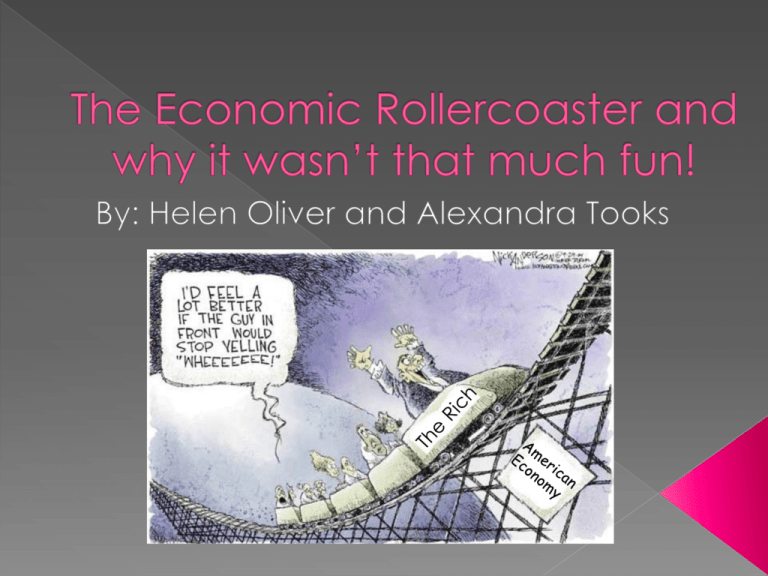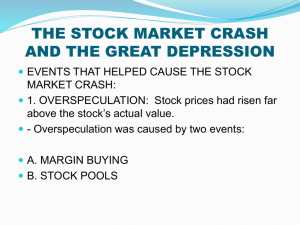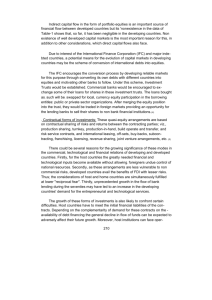boombust question 4 - Lincoln Park High School
advertisement

Analyze the factors that caused periods of economic prosperity and economic depression from 1800 to the present (1980) using specific examples to support your response. War, Overproduction, Technological Boom, Industrialization, Tariffs, Overspeculation, etc. Analyze the factors that caused periods of economic prosperity and economic depression from 1800 to the present using specific examples 1800 to 1980 to support your response. Panics: 1819, 1837, 1857, 1907 Depression of 1929 Wars Panics: › › › › › › › › 1819 (p. 242-243; 258) 1837 (p. 289, 383) 1857 (p. 428-429) 1873 (ch. 24) 1893 (Ch. 28) 1907 (p. 695-696) 1970s (ch. 42-43) Great Depression (ch. 36) Booms › › › › Cotton Boom Industrial Booms Western Expansion Technological Wars › 1812 (ch. 11-12) › Civil War (ch. 21-22) › Spanish-American War (ch. 29) › WWI (ch. 33) › WWII (ch. 37-38) › Cold War(p. 903-910; ch. 41-42) •Eli Whitney in 1793 built the Cotton Gin, •Cotton Industry is highly profitable •Increased the need for slavery •Led to textile industries being built in the North created prosperity for the whole nation •Textile industries, in turn, led to massproduction factories like Eli Whitney’s interchangeable parts for Muskets First Nation Panic Overspeculation of Western land Deflation and unemployment Loans from “wildcat” banks were not paid forcing the banks to close BUS looked at as a powerful evil (farmers perspective) › Foreclosed Mortgages Debtors prison looked at as inhumane: reform movements • Land Act (1820) • First Railroad (1828) • Mower Reaper by Cyrus McCormick (1830s) • Erie Canal (and Steam boats) • Creation of Millionaires due to industrial expansion • Widened gulf between rich and poor but also created great prosperity Get rich Quick-ism Overspeculation for Canals, Railroads, Slaves Borrowing Currency from the “wildcat” banks for Westward Expansion Specie Circular Bank Wars Wheat crop failure raises prices Whig party created • Independent • • • • • • Treasury (1840) John Deere’s steel plow (1837) 10 hr. days for federal employees (1840) Clipper Ships (1843) Telegraph by Samuel Morse (1844) Sewing Machine by Elias Howe (1846) Cotton Psychological rather than economic Incoming California Gold (Gold Rush) = inflation Crimean War (Europe) overstimulates grain growth Overspeculation of land and railroads Over 5,000 businesses failed (unemployment and hunger) North is hard hit; South is saved by cotton Reforming farmers want free land in the West Tariff of 1857 reduced the tariff by 25% Leads to the homestead Act Republican Party aimed at farmers rights •The Second Industrial Revolution was taking place during this time of prosperity •New Factories • Sheltered by protective tariffs and high inflation prices •More Millionaires •Labor-saving production •King Cotton “dethroned” •New industry •Jobs for women in place of men Overspeculation of Industries Banks give out too many loans Civil War after affects Greenbacks Inflationary policies created Temporarily dropped silver dollars (brought back shortly) Bank companies failed Resumption Act (withdrawal of greenbacks because they cause inflation) Contraction policy – brings up value of greenbacks Bland-Allison Act (1878): Treasury receive $2 million of gold and silver Trusts: vertical integration •Expansion of Railroads •Credit Mobilier Construction Company •Growth of Chinese migration and labor •Bessemer Process – invention in the 1850s •Big Trusts boosted Industry temporarily •Scandals •Consumerism •Inventions of telephone and electric light Workers Striking (troops called against them) Lasted 4 years Hobos (tramps) Overbuilding and overspeculation, labor disorders, agricultural depression European banks want American loans Free silver agitation: Sherman Silver Purchase Act and repeal of it (gold reserve dropped bellow $100 million) Federal government refused to help Selling of government bonds Banks lend government money “Commonwealth Army” Big business and courts allied Wilson-Gorman Bill •Big Major Events •Panama Canal (1901) •Puerto Rico (1898) •China (1899) •Hawaii (1893) •Philippines (beginning 1898) •Cuba (1898) •Roosevelt Corollary •Spanish-American War (1898) Sister Policy •Yellow Journalism •Increased Trade (easier) •Natural resources available •Controlling World markets •Revenue •Convenient Military Bases •Worldwide ties Purely Economic Panic Elkins Act (1903): began heavy fines on railroad and shippers that used special rebates Roosevelt’s “trust-busting”: attack on Northern industry › Hepburn Act (1906): Severely restricts free passes due to bribery › Meat Inspection Act and Pure Food and Drug Act (1906) Aldrich-Veerland Act (1908): authorizes banks to issue emergency currency Caused government to “relax assaults on the trusts” Led to fiscal (money) reform • During the war, • • • • American industries and farms produced goods New inventions such as the radio and cars Created strong Nationalism and faith in the American Economy Prohibition Roaring 20s • Credit • People could now buy things without the money to buy it and when post war economy declined the inability to pay with actual money left businesses and banks struggling to make ends meet. • Overproduction of Goods • Many people were also left without jobs because the surplus meant there was no need for more goods to be produced. • Stock Market Crash due to overspeculation • Many people lost their money and were unable to get it back after the value of their stocks dropped • Tariffs • The tariffs prevented foreign trade which prevented revenue from an outside source and left the surplus in American with nowhere for it to go. • War Debts • Britain and France refused to pay the debts to America because they felt that the Americans did not deserve it. •Truman and Eisenhower Doctrines (Marshall Plan) •Consumerism from new technology and modernism •Younger men took over the political scene •U.S. send a man into space (April, 1961) •Formation of the CIA •NATO •Geneva Summit Meeting •G.I. Bill •Need to achieve STABILITY •Civil Rights Movements •Questioning and improvement of education Productivity gains slowed Work involved fewer skills because women and teenagers were entering the workforce Decline in machinery investments Emphasis on the services rather than manufacturing Vietnam war drained tax dollars Oil prices rising Cost of living more than tripled No modernization of industries put America behind the newer industries (Japan and Germany) Americans now have a sense of limit (they understand that things cannot continue to grow forever) Supply-side economics begins Reganomics Higher interest rates Lower union participation Trusts built up again Poor get poorer; wealthy get wealthier Economic Recession The Stock Market prospers (then crashes once illegal traders are caught) Results Supply-side economy Cut taxes and all government programs and spending “Trickle Down” Increased Military spending DEREGULATE Expanding business growth Are there any questions or comments?





